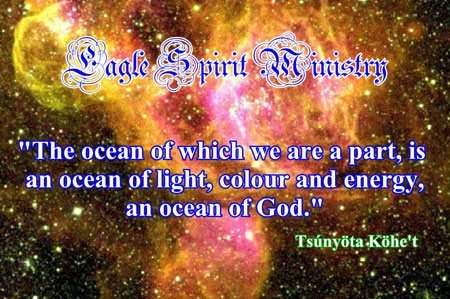 |
 |
|
|
||
|
Presented by…
|
||
|
|
||
|
Colour is an integral part of our existence. Everywhere that we look we find colour. In our clothing, furnishings, natural settings, and even within our own personalities. The world would be a pretty drab place if we only perceived varying shades of black, white and grey to reveal a somewhat monochromatic view. Colour is actually a vibration of light and what we see is a reflection of that essence to reveal a wide variety of hues to add flavour to our visual perceptions. We can perceive many colours, to include the hues that we wear, the shades reflected through the rainbow, and even the energy field which envelops our bodies. Those who are visually impaired are able to perceive the vibratory rate of colours, often in their mind's eye or through the sense of feel. The psychological preference for certain colours is evidenced by the traditional meanings we associate with the shades as in western traditions such as brides wear white, mourners wear black, and authority figures wear blue or black. The reasons why we subconsciously select one colour over another are influenced by psychological implications, which transcend conscious awareness because colour carries archetypal elements dating back to antiquity. |
||
 |
||
|
While colour does appear to carry with it superficial applications including the selection of cosmetics, clothes and accessories, or decoration of buildings or objects, we subconsciously select the hues which we need to add balance to our overall being. Holistically, colour has much therapeutic significance as there has been an upsurge in alternative healing techniques which use its principles, such as colour therapy, crystal healing, and even various forms of hands on healing to include Reiki, therapeutic touch and shiatsu. It is worth understanding a little about the relevance of the hues in our light spectrum, because colour has such a paramount influence in our daily lives. We are only able to perceive approximately one sixtieth of the hues in our light spectrum, as light and colour: |
||
 |
||
|
Red is the first colour in the light spectrum which can be seen by the human eye. Red is representative of survival instincts, action and security. As a rule, red represents our sex drive because Red governs the sexual organs. A lesser known fact about Red, is that Red actually rules our ability to feel secure within ourselves, and is associated the base of the spine. We tend to wear Red when we desire energy, or would like to make an impact, or attract attention. Some of the softer shades, such as tomato Red, actually promote a sense of well being, because they have a grounding influence, and can be worn by practically anyone. |
||
 |
||
|
Orange is the second colour to be seen in the spectrum. Orange represents liveliness and happy memories. Many young people are drawn to the warming influence which Orange projects, because of its vibrancy. Orange governs the kidneys and brings about an emotional release of energy. We choose Orange when we want to have fun, draw attention to ourselves, or project an air of authority amongst our peers. |
||
|
|
||
|
Yellow is considered to represent the intellect, because Yellow is associated with mental imagery. Yellow governs the solar plexus, and like the Sun, Yellow is a vibrant life force. Yellow is happy, lively, and gives us a sense of self confidence to help us cope during stressful situations. |
||
|
|
||
|
Although when jealous one is said to be 'green with envy', Green is a principle hue used for healing, because of its calming, soothing properties which help to promote health and well being. Green governs the heart and is therefore associated with love and harmony. We tend to choose Green when we want to feel calm, stable and closer to the earth. Ironically, Green has traditionally been associated with uniforms in the armed forces, but it is quite possible that the prevalent grounding influences of Green, provide the stability which is needed to maintain order and preserve peace. |
||
 |
||
|
Pink is a colour of love, compassion and femininity. Pink co-governs the heart with green, and represents understanding and admiration. We tend to select Pink when we want to appear friendly, approachable, and in touch with the receptive side of ourselves. Pink is often associated with happy memories, because Pink places us in touch with good times of long ago. |
||
 |
||
|
Turquoise is a colour of deep compassion and inner healing. Turquoise relates to our ability to love ourselves, as well as others. Turquoise governs the thymus and is therefore related to the immune system of the body. We will select Turquoise when we want to appear friendly and approachable, with just a hint of sophistication. |
||
 |
||
|
Blue is universally considered to be the friendliest colour in the spectrum. Blue governs the throat, so Blue corresponds with our ability to communicate with others. Colds and sore throats may be an indication that we need to be more conscientious of how we relate to others. Blue is selected by those who would like to appear knowledgeable, responsible and exert an aura of credibility, whilst being seen as approachable and socially aware. |
||
 |
||
|
Purple has long been considered to be the colour of royalty, dating back to a time when the monarchy was considered to have a direct link to God. Purple is associated with the brow, or third eye, and represents insight, wisdom and our ability to see beyond what is considered to be the normal span of visual perceptions. We will select purple when we want to stand out in a crowd, or appear different. |
||
 |
||
|
Magenta is a mixture of red and purple, and is considered to represent universal harmony. Magenta governs the crown of the head and deals with our ability to transcend the here and now, to experience a sense of higher cognition. Magenta is strong, bright, and carries with it a sense of vivacity which more timid souls might find uncomfortable to wear. We tend to select Magenta when we would like to draw striking attention to ourselves. |
||
 |
||
|
Indigo is a mixture of blue and purple, and contains much depth which dates back to the attire of early spiritual leaders. Indigo is considered to be one of the most inspired colours in the spectrum, because Indigo is associated with the crown. We tend to wear Indigo when we wish to make a strong impact on those around us, as well as project an aura of psychic depth. |
||
 |
||
|
Lavender is a calming colour which is approachable and puts others at ease. Lavender is popular for weddings and similar occasions, because Lavender is harmonious. |
||
 |
||
|
White is a combination of all colours within the light spectrum. White is considered to be a colour of truth, knowledge and illumination. Those in the medical or therapeutic professions choose White as a symbol of cleanliness and hygiene, because any speck of dust can easily be seen. We tend to select White when we would like to make a dramatic impression on others. |
||
 |
||
|
Brown is a combination of the three primary colours red, yellow and blue. Brown is an earthy, practical colour which is sincere in nature, but may be considered to be a bit too conventional for some. Many consider Brown to be unsuitable for business, but Brown's friendly approachability, will assist to put people at ease in stressful situations. |
||
 |
||
|
Black is considered to be the absence of colour and Black often misunderstood. Black represents unresolved, thwarted ambitions which have resulted in disease, and a profound forgetfulness as in the case of when people loose sight of their purpose in life. Black has been given much bad publicity throughout the ages, but deep velvety Black can bring about an intense sense of healing, which cannot be penetrated by the other colours, which is why many in mourning wear Black. We select Black when we want to appear authoritative, and make a strong impact on those around us. |
||
 |
||
|
Grey is a combination of white and black. Grey has the unusual distinction of being a combination of all colours, and absence of colour at the same time. Grey is considered to be a colour which is appropriate when we do not wish to make a stand, and desire to remain unnoticed. |
||
 |
||
For More About Colours…. |
||
|
|||||
 |
||
|
|
|
 |
|

